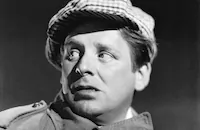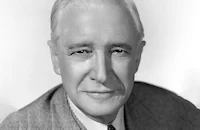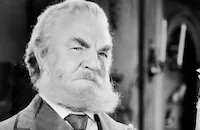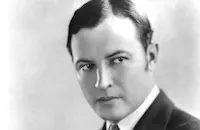Men in White

Brief Synopsis
Cast & Crew
Richard Boleslavsky
Clark Gable
Myrna Loy
Jean Hersholt
Elizabeth Allen
Otto Kruger
Film Details
Technical Specs

Synopsis
After a long, difficult day at the hospital, intern Dr. George Ferguson is ordered to forego a dinner date with his fiancée, Laura Hudson, and remain on duty all night to administer a possible blood transfusion. When George then breaks his date with Laura, whose wealthy father John is a patient in the hospital, she angrily expresses her disappointment and tells him that after they marry and he finishes his studies in Vienna, he will have to maintain more regular hours. That night, after he defies a senior doctor's orders but saves a young girl's life, George learns that the transfusion patient has died and immediately telephones Laura. Despite George's pleas, Laura refuses to see him that night, and George returns to his hospital dormitory room. Soon after, Barbara Dennin, a British student nurse, comes to George's room and asks to borrow notes for an upcoming examination. Both lonely and exhausted, George and Barbara share their fears and doubts about the medical profession and then give in to their sexual attractions. Later, hospital board members, concerned over rising operating costs, suggest to Dr. Hochberg, George's mentor and the hospital's head physician, that they ask Hudson for a large donation and encourage his philanthropy by offering George a prestigious appointment. Hochberg rejects the idea, confident that his student will never choose an unearned, easy job over his vital hospital work. George, however, confesses to Hochberg that, because of pressure from Laura, he is having doubts about pursuing his gruelling hospital career. Before Hochberg can persuade him otherwise, George learns that Barbara is seriously ill from a bungled abortion and requires emergency surgery. On orders from Hochberg, Laura dons a surgical gown and accompanies George into Barbara's operating theater. Just before Barbara succumbs to the ether, she tells George that she loves him, a confession heard by Laura. During the operation, Laura faints and later refuses to talk or see George. Devastated, George tells a knowing Hochberg that, although he stills loves Laura, he must marry Barbara and start his own practice to support her. Hochberg then counsels Laura to give up George and sends her to see Barbara. Near death, Barbara asks Laura to forgive both her and George, then, while clutching George's hand, dies. Now fully aware of George's calling, Laura tells him she is leaving for Europe without him, but plans to visit him someday in Vienna.

Director

Richard Boleslavsky
Cast

Clark Gable

Myrna Loy

Jean Hersholt

Elizabeth Allen

Otto Kruger

C. Henry Gordon
Russell Hardie

Wallace Ford

Henry B. Walthall

Russell Hopton

Samuel S. Hinds

Frank Puglia
Leo Chalzel

Donald Douglas
Nell Craig
Isabel Lamal
Sonya Von Berry
Eulalie Jensen
Claudelle Kaye

Mary Maclaren
Purnell B. Pratt
Perry Ivins
Broderick O'farrell
Jill Dennett
Claudia Coleman
Frank Burke

Dorothy Peterson
Dorothy Gray
Sarah Padden
Wallis Clark
Ray Cooke
Ruth Mannix
Treva Lawler

Lee Phelps

Berton Churchill
Harry C. Bradley

Robert Frazer

Ann Gillis
Crew
Adrian
Dr. William Axt
Monta Bell
George Folsey
Cedric Gibbons
Red Golden
Merrill Page
Douglas Shearer
Frank Sullivan
Edwin B. Willis
Waldemar Young

Film Details
Technical Specs

Articles
Men in White
At the time, Men in White was more significant as a turning point in Clark Gable's career. Although he had already proven himself adept at comedy (It Happened One Night, 1934) and tough-guy roles (Red Dust, 1932), Men in White gave him an opportunity to display a more sensitive side as well as a broader dramatic range. The critics were suitably impressed; The Film Daily wrote that Gable was "very real and warm and unlike anything we've seen him doing before" and the Motion Picture Herald proclaimed that "Gable does a remarkable acting job." MGM wasted no time in grooming the actor for bigger and better things as witnessed by his breakout performance the following year in the historical epic, Mutiny on the Bounty (1935), for which he received a second Oscar® nomination for Best Actor.
Based on the Pulitzer Prize-winning play by Sidney Kingsley (Dead End, 1937) the controversial nature of the material was considerably toned down for the movie version of Men in White. After the racy, anything-goes period of the Pre-Code era, censors were much more vigilant about prohibiting potentially inflammatory subjects like abortion from being depicted on movie screens. Yet, it is exactly that topic which gave Kingsley's original story such power and urgency. In an interview, the playwright later stated that "At that time, there were millions of illegal abortions in the United States, and God knows how many women died because they weren't operated on with proper medical care." Unfortunately, Men in White carefully sidesteps the whole situation by never showing or discussing Barbara's ill-fated abortion; Instead, the movie concentrates on the up and down love affair of Dr. Ferguson and his fiancee though George's one-night stand with the nurse and its consequences is never in doubt.
Men in White marked the first of seven films that Gable would make with Myrna Loy and it was not an auspicious beginning according to the actress in her autobiography, Myrna Loy: Being and Becoming. She revealed that Gable, who was married at the time, had tried to make a pass at her (she rejected him) after bringing her home from a social event - while his wife sat in the car! Loy said, "When I saw Clark at the studio soon after that, he walked right past me with his nose in the air. Next thing I knew, we were cast together in Men in White...When we started the film, Clark developed a pretty serious thing with Elizabeth Allan, a lovely English girl in the cast, and greeted her with coffee and cakes every morning. The crew always put out sweet breads, so Clark would load up and, just to get my goat, walk right past me to Elizabeth. He was punishing me. We managed to be convincing lovers on camera, which wasn't easy while he virtually ignored me. That Dutchman just wasn't taking no for an answer." Loy and Gable never did become lovers but they did end up as good friends through their subsequent collaborations at MGM.
Some additional trivia on Men in White: Franchot Tone was initially considered for the role of Dr. Ferguson when Gable was temporarily unavailable; Jean Hersholt, who plays Dr. Hochberg in the film, would go on to be honored twice by the Academy of Arts and Sciences - once in 1939 for serving as the President of the Motion Picture Relief Fund and once in 1949 for his "distinguished service to the motion-picture industry." Men in White would later be produced for television in 1960 with Richard Basehart.
Producer: Monta Bell
Director: Richard Boleslawski
Screenplay: Waldemar Young, based on the play by Sidney Kingsley
Cinematography: George Folsey
Film Editing: Frank Sullivan
Art Direction: Cedric Gibbons
Music: William Axt
Cast: Clark Gable (Dr. George Ferguson), Myrna Loy (Laura Hudson), Jean Hersholt (Dr. Hochberg), Elizabeth Allan (Barbara Denham), Otto Kruger (Dr. Levine), C. Henry Gordon (Dr. Cunningham).
BW-74m.
by Jeff Stafford

Men in White
Quotes
Trivia
The original play opened in New York on 26 September 1933.
When the film was released, the play was still being performed in Los Angeles and New York. Release for those cities was delayed until the end of the run of the play.
Because of the suggested illicit romance and the suggested abortion in the movie, it was frequently cut. The Legion of Decency cited the movie as unfit for public exhibition.
Notes
Sidney Kingsley's play won the Pulitzer Prize in 1933. At the time of this film's release, the play, which was a Group Theatre production, was still being performed in New York and Los Angeles. Variety states that the film's release was to be delayed in those cities until the end of the play's run, as stipulated by M-G-M's contract. According to a November 1933 Hollywood Reporter news item, Franchot Tone was considered for the role of "Dr. George Ferguson" after Gable was temporarily unavailable. Lionel Barrymore was also under consideration for a part in the film. Film Daily news items add Isabel Jewell, Eddie Nugent, Frank Reicher and Ruth Channing to the cast. Their participation in the final film has not been confirmed. Although implicitly expressed by the story's actions, "Barbara's" sexual relations with "George" and her subsequent pregnancy and failed abortion are never seen or discussed directly in the picture. Files contained in the MPAA/PCA Collection at the AMPAS Library indicate that because the film "suggested abortion," it was "widely cut, and it was one of the pictures which was cited as unfit for public exhibition by the Legion of Decency." At the time of the picture's release, "a storm of protest broke out," according to the Hays Office files. In 1960, the CBS television network broadcast a version of Kingsley's play, which was directed by Don Richardson and starred Richard Basehart.















